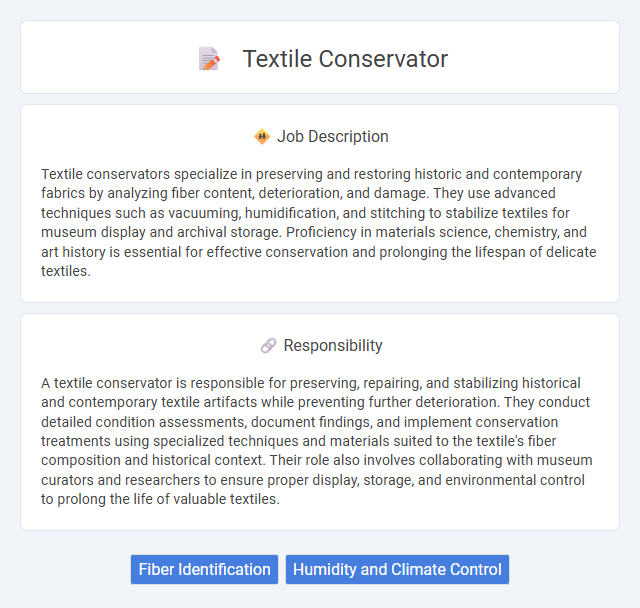
Textile conservators specialize in preserving and restoring historic and contemporary fabrics by analyzing fiber content, deterioration, and damage. They use advanced techniques such as vacuuming, humidification, and stitching to stabilize textiles for museum display and archival storage. Proficiency in materials science, chemistry, and art history is essential for effective conservation and prolonging the lifespan of delicate textiles.
Individuals with strong attention to detail and patience are likely to be well-suited for a textile conservator role, as the job often involves delicate and meticulous work. Those with physical stamina and good hand-eye coordination may find the tasks manageable, though people with certain allergies or sensitivities to chemicals might face challenges. A background in art history or chemistry will probably increase compatibility with the job's technical demands.
Qualification
Textile conservators typically hold a bachelor's or master's degree in textile conservation, art conservation, or a related field such as chemistry or fine arts. Advanced training often includes internships or apprenticeships in museums or conservation labs, emphasizing hands-on experience with fabric preservation techniques and historical textile analysis. Proficiency in fiber science, knowledge of textile degradation processes, and expertise in using conservation tools and materials are critical qualifications for this role.
Responsibility
A textile conservator is responsible for preserving, repairing, and stabilizing historical and contemporary textile artifacts while preventing further deterioration. They conduct detailed condition assessments, document findings, and implement conservation treatments using specialized techniques and materials suited to the textile's fiber composition and historical context. Their role also involves collaborating with museum curators and researchers to ensure proper display, storage, and environmental control to prolong the life of valuable textiles.
Benefit
Textile conservators likely enjoy the benefit of preserving valuable historical and cultural artifacts, which provides a unique sense of purpose and fulfillment. The role probably offers opportunities for continuous learning and working with advanced preservation techniques. Employment in museums, archives, or private collections might also provide stable career prospects with specialized professional recognition.
Challenge
Working as a textile conservator likely involves the challenge of balancing delicate restoration techniques with the need to preserve the fabric's historical integrity. There is a probability that each artifact presents unique deterioration patterns requiring specialized knowledge and innovative approaches. Managing environmental factors and unpredictable material reactions may also pose ongoing difficulties in ensuring long-term preservation.
Career Advancement
Textile conservators advance their careers by gaining specialized knowledge in fabric preservation techniques and historical textile analysis, often pursuing certifications or advanced degrees in conservation science. Progression opportunities include senior conservator roles, research positions in museums, or leadership roles in heritage preservation organizations. Developing expertise in contemporary conservation technology and grant writing significantly enhances prospects for career growth and securing high-profile projects.
Key Terms
Fiber Identification
Fiber identification is a critical skill for textile conservators, enabling accurate analysis and preservation of historical fabrics. Techniques such as microscopy, FTIR spectroscopy, and polarized light are employed to distinguish natural from synthetic fibers. Precise fiber identification informs appropriate conservation treatments and materials selection, ensuring the longevity of textile artifacts.
Humidity and Climate Control
Textile conservators rely on precise humidity and climate control to prevent fabric deterioration, mold growth, and color fading. Maintaining relative humidity levels between 45-55% and temperature around 18-22degC is critical to preserving delicate fibers and minimizing mechanical stress. Advanced HVAC systems and data loggers are essential tools for continuous monitoring and maintaining optimal environmental conditions in textile storage and display.
 kuljobs.com
kuljobs.com